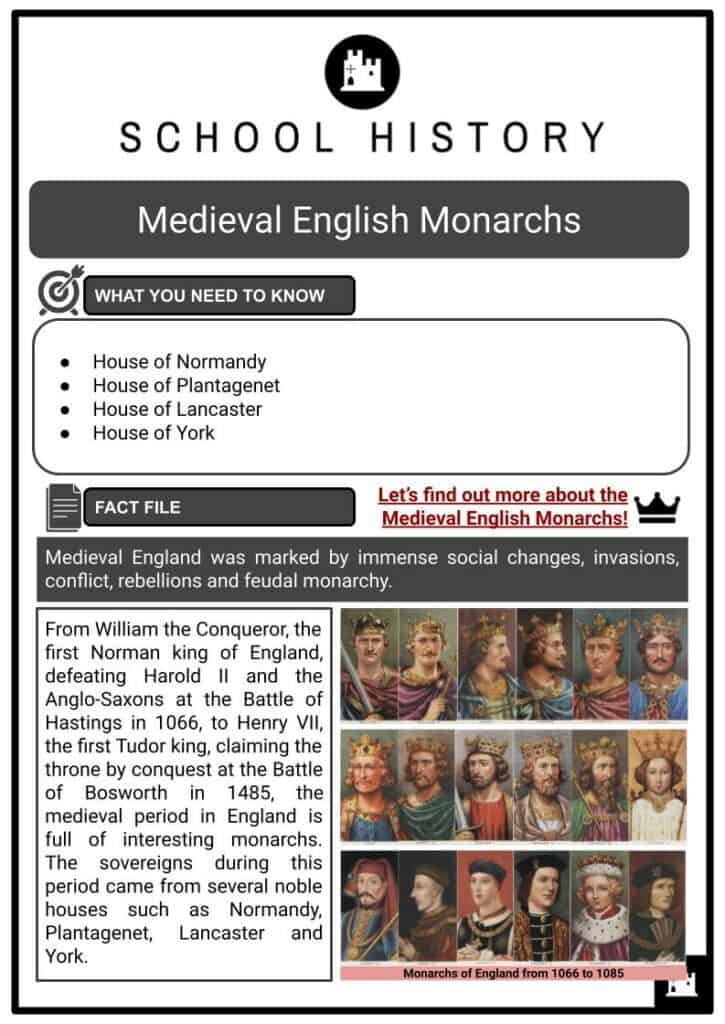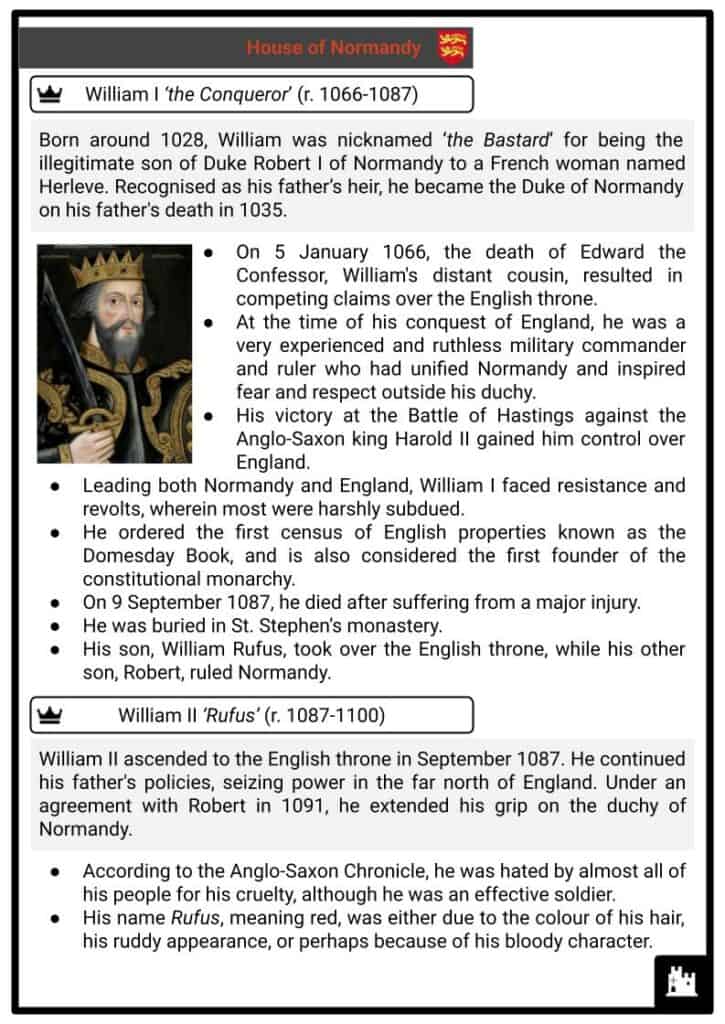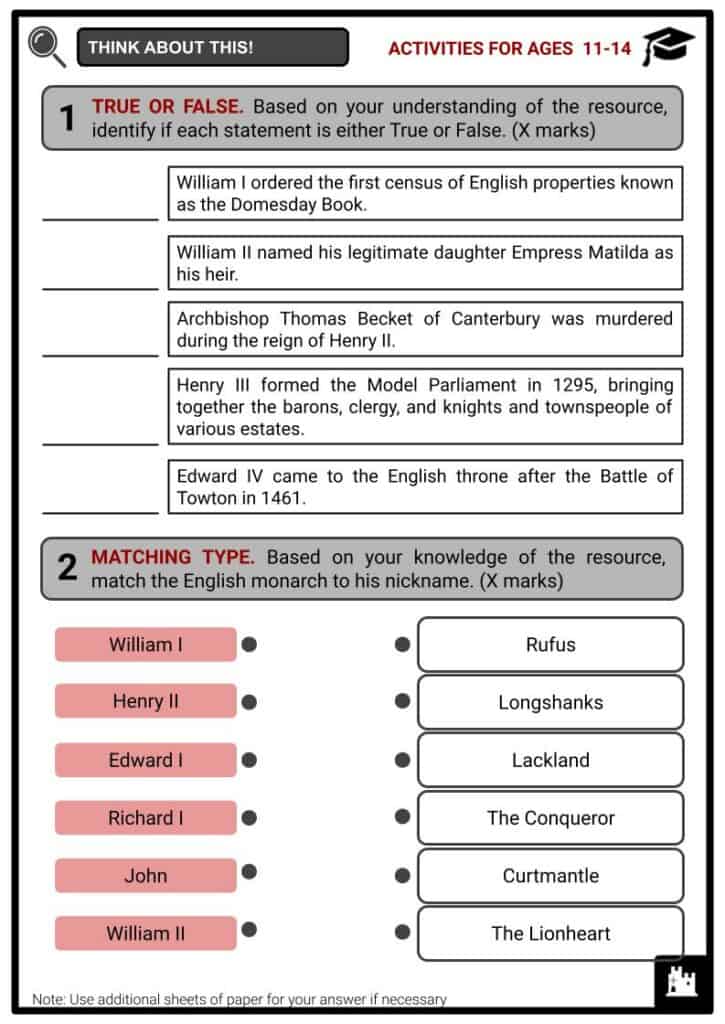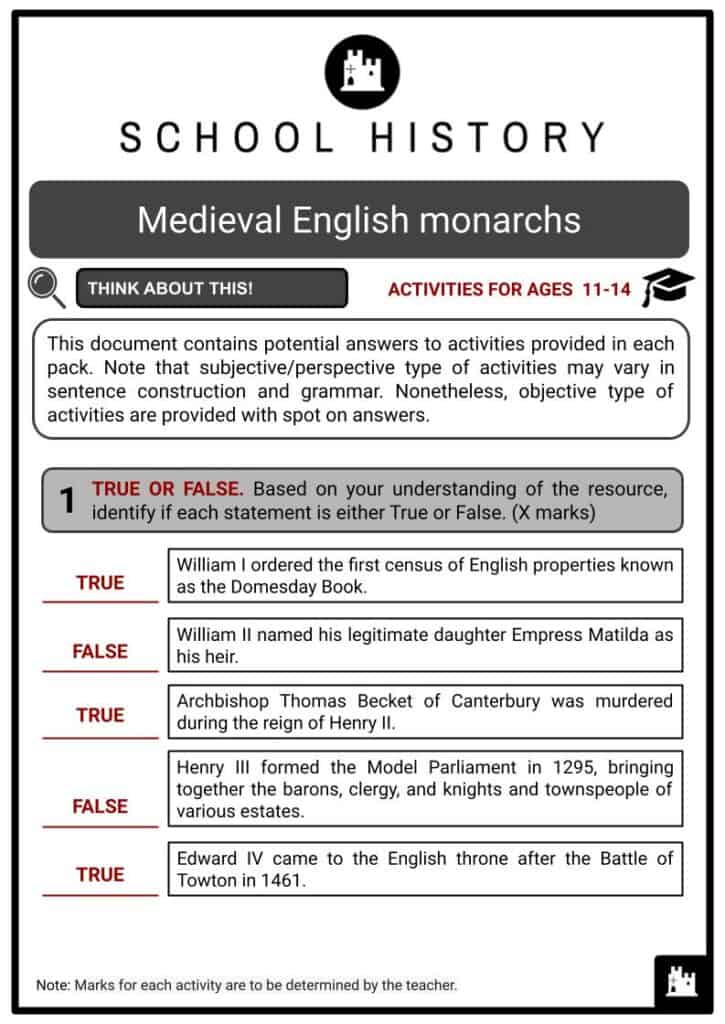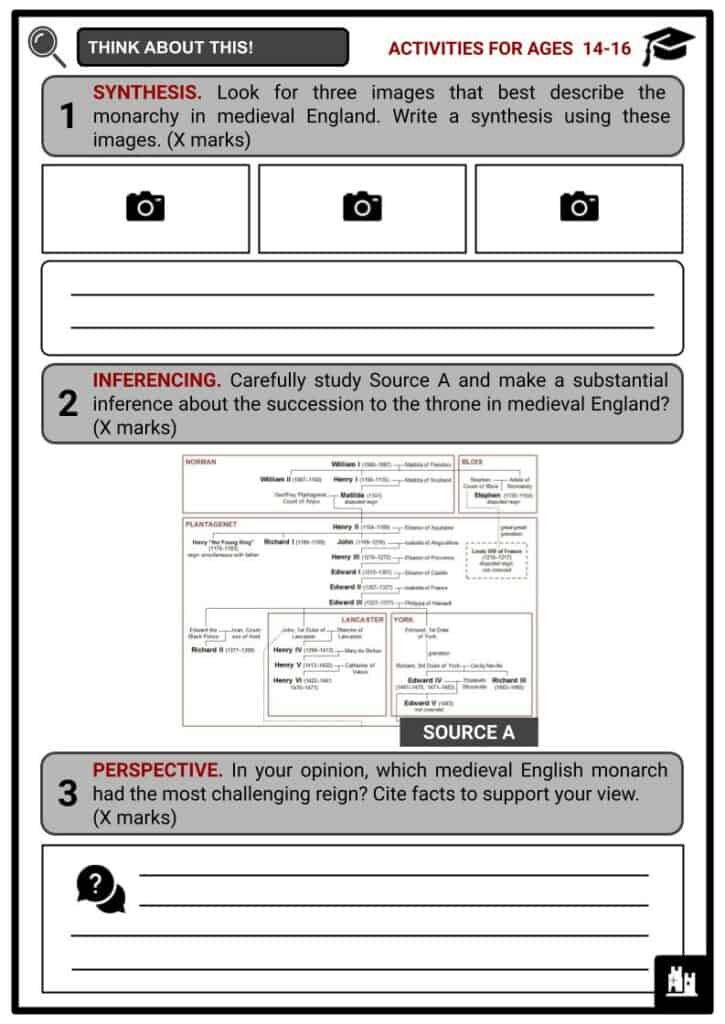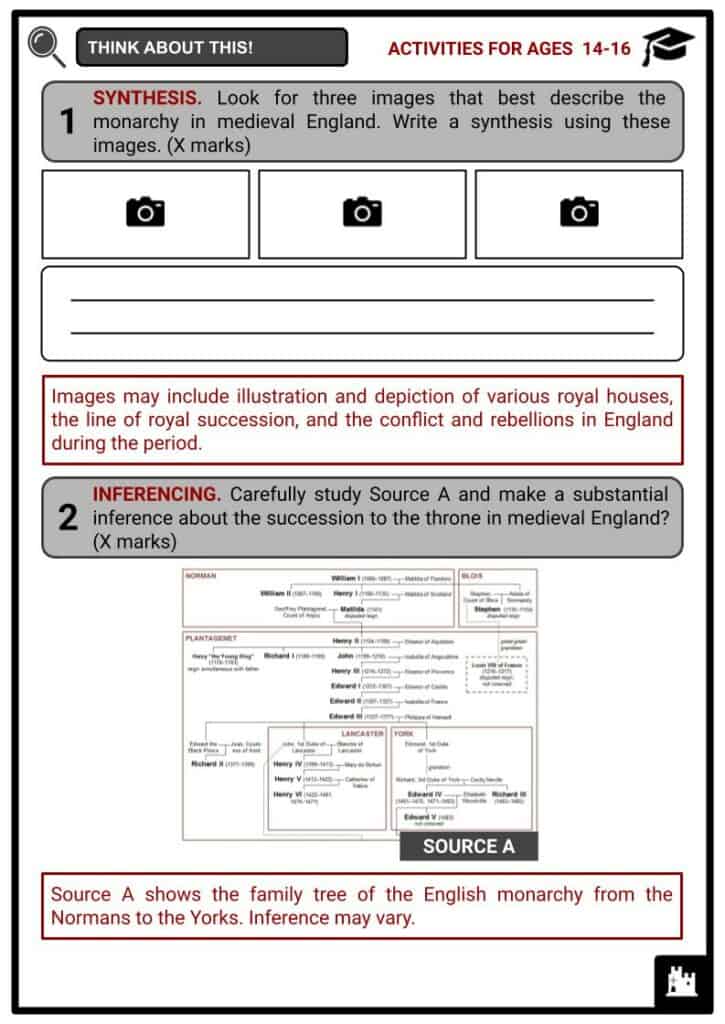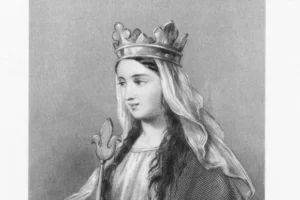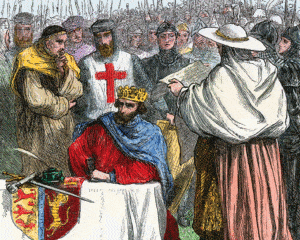Download Medieval English Monarchs Worksheets
Do you want to save dozens of hours in time? Get your evenings and weekends back? Be able to teach Medieval English monarchs to your students?
Our worksheet bundle includes a fact file and printable worksheets and student activities. Perfect for both the classroom and homeschooling!
Summary
- House of Normandy
- House of Plantagenet
- House of Lancaster
- House of York
Key Facts And Information
Let’s know more about Medieval English monarchs
From William the Conqueror, the first Norman king of England, defeating Harold II and the Anglo-Saxons at the Battle of Hastings in 1066, to Henry VII, the first Tudor king, claiming the throne by conquest at the Battle of Bosworth in 1485, the medieval period in England is full of interesting monarchs. The sovereigns during this period came from several noble houses such as Normandy, Plantagenet, Lancaster and York.
House of Normandy
William I ‘the Conqueror’ (r. 1066-1087)
- Born around 1028, William was nicknamed ‘the Bastard’ for being the illegitimate son of Duke Robert I of Normandy to a French woman named Herleve. Recognised as his father’s heir, he became the Duke of Normandy on his father's death in 1035.
- On 5 January 1066, the death of Edward the Confessor, William's distant cousin, resulted in competing claims over the English throne.
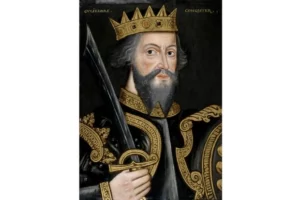
- At the time of his conquest of England, he was a very experienced and ruthless military commander and ruler who had unified Normandy and inspired fear and respect outside his duchy.
- His victory at the Battle of Hastings against the Anglo-Saxon king Harold II gained him control over England.
- Leading both Normandy and England, William I faced resistance and revolts, wherein most were harshly subdued.
- He ordered the first census of English properties known as the Domesday Book, and is also considered the first founder of the constitutional monarchy.
- On 9 September 1087, he died after suffering from a major injury.
- He was buried in St. Stephen’s monastery.
- His son, William Rufus, took over the English throne, while his other son, Robert, ruled Normandy.
William II ‘Rufus’ (r. 1087-1100)
- William II ascended to the English throne in September 1087. He continued his father's policies, seizing power in the far north of England. Under an agreement with Robert in 1091, he extended his grip on the duchy of Normandy.
- According to the Anglo-Saxon Chronicle, he was hated by almost all of his people for his cruelty, although he was an effective soldier.
- His name Rufus, meaning red, was either due to the colour of his hair, his ruddy appearance, or perhaps because of his bloody character.
- His relations with the Church were not easy.
- It is not surprising that the chroniclers of the time judged him harshly, in fact, all the scholars of the time were churchmen against whom William II fought long and hard.
- He seemed to have an extrovert character and his reign was marked by his aggressive temper and contempt for the English and their culture.
- He was unmarried and childless when he died from a hunting accident on 2 August 1100 in the New Forest.
- His youngest brother succeeded him.
Henry I ‘Beauclerc’ (r. 1100-1135)
- Henry I ascended to the English throne on 5 August 1100. His name Beauclerc, meaning ‘the Cleric’, indicated his good education.
- After he successfully completed his conquest of Normandy from Robert in 1106, he centralised the administration of England and Normandy in the royal court.
- His legitimate sons William and Richard drowned in the White Ship in 1120, causing a succession problem, as Henry I refused to name any of his numerous illegitimate children as heir to England or Normandy.
- His reign is known for his skillful political opportunism, the improvement of the government, the integration of the Anglo-Saxons and Normans into his kingdom, the reunification of his father’s domains, and his controversial, yet well-founded, decision to name his legitimate daughter as his heir.
- He died in 1135.
Stephen (r. 1135-1154) and Empress Matilda (r. April - November 1141)
- Stephen of Blois secured his succession to the English throne on the death of Henry I. He was the son of Henry I's sister Adela. His election and coronation disregarded the oath he and his fellow barons had sworn in 1127 to Henry I's daughter, Empress Matilda. Whilst he was an attractive and brave warrior, he failed to inspire loyalty among his subjects.
- Despite the support and influence of his wife Matilda of Boulogne and his brother Henry of Blois, Stephen could neither control his friends nor overpower his enemies.
- His reign was marked by a war of succession which saw Stephen against his cousin Empress Matilda as claimant to the English throne.
- Empress Matilda invaded England in 1139, and the country was plunged into a civil war known as the Anarchy.
- During the Anarchy, local feuds were pursued under the cover of the civil war, and the bond between the King and the nobles was damaged.
- Whilst Stephen's defeat seemed certain in 1141, the arrogant behaviour of Empress Matilda was disliked even by her own supporters.
- Following the death of her illegitimate half-brother, Earl Robert of Gloucester, Empress Matilda retired to Normandy in 1147 leaving the English throne to Stephen.
- Stephen's throne was still disputed, now by Empress Matilda's eldest son, Henry.
- Henry invaded England in 1149 and again in 1153, which Stephen fought stubbornly.
- The Treaty of Wallingford was negotiated in 1153, under which Henry would inherit the throne after Stephen's death.
House of Plantagenet
Henry II ‘Curtmantle’ (r. 1154-1189)
- Henry II was the King of England from 19 December 1154 until his death on 6 July 1189. As the English king, he held authority over certain regions in Wales, Scotland, and eastern Ireland. Due to his territories in what is now France, he spent most of his years as king on the continent. He was nicknamed Curtmantle because he preferred to wear short hunting-style jackets instead of long robes.
- In contrast to the controversial reign of Stephen, Henry II's was solid.
- A proud, energetic, and tireless man who was interested in government and law, he made use of juries and re-introduced the sending of justices on regular tours of the country to try cases for the Crown.
- For his legal reforms, he is considered as the founder of English Common Law.
- Henry II's conflict with the Archbishop Thomas Becket of Canterbury over Church-State relations ended in the archbishop’s murder in 1170 and a papal interdict on England.
- His achievements were almost wrecked by family disputes over territorial ambitions.
- Henry II died in France in 1189, while at war with his son Richard, who allied with King Philip of France to attack Normandy.
Richard I 'the Lionheart' (r. 1189-1199)
- Richard I, also known as Richard the Lionheart, was King of England, Duke of Normandy, Duke of Aquitaine, Count of Poitiers, Count of Maine and Count of Anjou from 1189 until his death in 1199. The eldest surviving son of Henry II and Eleanor of Aquitaine, he was raised in the Duchy of Aquitaine at his mother’s court.
- After the sudden death of his older brother Henry the Younger in 1183, he became heir to the crowns of England, Anjou, Normandy, and Maine.
- During his reign, which lasted ten years, he only lived in England for a few months and never learnt English.
- He used all his resources in joining the Third Crusade in 1990 and in defending his French territories against King Phillip II of France.
- Richard I spent the last years of his life in France.
- In 1199, he died during a minor siege of the castle of Châlus against a rebellious baron.
- He was considered a hero and is often described as such in literature.
John ‘Lackland’ (r. 1199-1216)
- John was King of England, Lord of Ireland and Duke of Aquitaine from 1199 until his death in 1216. As the fifth and last son of Henry II, he was not destined to ascend to the throne or to receive any territory as an inheritance. For this, he was nicknamed Lackland, meaning without a land, by his father.
- He tried unsuccessfully to seize power while his brother was participating in the Third Crusade.
- When he became king, he was immediately confronted with the threat posed by King Philip II of France on his continental territories that formed the Plantagenet Empire.
- Despite his efforts to reclaim his French possessions, a new offensive in 1214 ended in the defeat of his allies at Bouvines, and he was forced to return to England.
- Unhappy with his tyrannical behaviour and the sharp rise in taxes to finance his continental policy, the English barons revolted.
- The dispute entailed the sealing of the Magna Carta in 1215. The Magna Carta limited royal powers, defined feudal obligations between the King and the barons, and guaranteed a number of rights.
- Due to the failure of the Magna Carta as a peace treaty, the rebels invited King Louis VIII of France to become their king.
- When John died in 1216, England was in the grip of civil war.
Henry III (r. 1216-1272)
- Henry III was king of England, and Duke of Aquitaine and Gascony from 1216 until his death in 1272. The eldest son of John Lackland and Isabella of Angouleme, he was only nine when he acceded to the English throne. When he assumed power from his regent in 1227, order had been restored in England based on his acceptance of the Magna Carta.
- His reign was troubled with further disputes with the barons and united opposition in Church and states due to his failed campaigns in France in 1230 and 1242, his choice of friends and advisers, and his expensive intervention in Sicilian affairs.
- Forced by Parliament to approve the Provisions of Oxford in 1258 and the Provisions of Westminster in 1259, the annulment of such provisions in 1264 led to the barons’ revolts.
- Royal authority was restored by the Statute of Marlborough in 1267 with Henry III promising to uphold Magna Carta and some of the Provisions of Westminster.
Edward I ‘Longshanks’ (r. 1272-1307)
- Edward I was King of England and Duke of Aquitaine from 1272 to 1307. He was the eldest son of Henry III and of Eleanor of Provence. He was nicknamed Longshanks because of his stature. At the time of his succession, he was a veteran warrior who had a track record in military ability and a proven determination to give peace to the country.
- Determined to enforce primacy and royal authority in the British Isles, he successfully subdued the Welsh opposition to his rule.
- Wales was brought into the English legal framework and the shire system was extended under the Statute of Wales of 1284.
- He formed the Model Parliament in 1295, bringing together the barons, clergy, and knights and townspeople of various estates.
- Parliament usually comprised representatives of all these estates by the end of Edward I's reign.
- During his reign, he promoted the uniform administration of justice, codified the legal system and fought wars against the Scots.
- He is credited with the establishment of Parliament as a permanent institution and thereby also a functional system for raising taxes.
- In July 1307, he died en route to another campaign against Scotland.
Edward II (r. 1307-1327)
- Edward II was King of England from 1307 until his deposition in January 1327. He was the fourth son of Edward I. From 1300, he accompanied his father on the pacification campaigns in Scotland, and in 1306 he was knighted at Westminster Abbey.
- In 1308, he married Isabella of France in order to resolve the tensions between the English and French crowns.
- During his reign, he surrounded himself with favourites and as a result, different baronial groups struggled to gain power and control the king.
- His victory in a civil war in 1321-1322 and measures such as the 1326 ordinance failed to deliver any compromise between the king and the nobles.
- In 1327, he was forced to renounce the throne in favour of his son. He was murdered at Berkeley Castle that same year.
Edward III (r. 1327-1377)
- Edward III was King of England and Lord of Ireland from 1327 until his death. He was in his minority when he ascended to the throne and only assumed government in his own right from 1330. Throughout his reign, he strongly supported and promoted the cavalry, which allowed him to develop good relations with the nobility of the kingdom.
- His reign was marked by the expansion of English territory through wars in Scotland and France known as the Hundred Years War.
- Wars needed money, and to this end he reformed the coinage and came increasingly to rely on parliament to organise the economy and deal with law and order within the realm.
- Furthermore, the Black Death plague outbreaks inflicted severe social disorder and caused deflation, thus severe laws were introduced to attempt to fix wages and prices.
- As he aged, he withdrew from the administration of the realm. He died from a stroke in 1377.
Richard II (r. 1377-1399)
- Richard II ascended to the English throne in 1377 at only ten years old. His regency council faced all sorts of problems, which helped lead to the Peasant's Revolt in 1381. The leader of the Revolt, Wat Tyler, was killed, and the uprisings were defeated over the next few weeks.
- He set on a path of tyranny and often clashed with his parliament.
- Declaring himself of age, he then proceeded to rule by fear and attempted to reduce parliament to a talking shop.
- In 1399, Henry Bolingbroke had the country rise in his favour while the king was in Ireland and declared himself king as heir of Henry III and by right of conquest.
- Richard II was deposed by Henry and passed on to a bitter end at Pontefract Castle, either by smothering or self-starvation.
House of Lancaster
Henry IV (r. 1399-1413)
- Henry IV came to the English throne in 1399 by force. He was a grandson of Edward III and the son of John of Gaunt and Blanche of Lancaster. His successful usurpation started a dispute between the House of Lancaster and the House of York. Moreover, his claim to the throne was not recognised by many.
- He spent much of the early part of his reign fighting to keep control of his lands.
- His rule was marked by repeated rebellions in the North and the West.
- Despite this, he successfully held the Crown and crushed the oppositions.
- Whilst he was suffering from illness from 1405 onwards, his son Henry played a greater role in government.
- He died, exhausted, in 1413 in the Jerusalem Chamber at Westminster Abbey.
Henry V (r. 1413-1422)
- Henry V became the King of England in 1413 after the death of his father Henry IV. He was an excellent general who had gained military experience in his younger years. In 1415, he laid claim to the French crown.
- He went on to defeat the French at the Battle of Agincourt and was able to gain control of Normandy in subsequent campaigns.
- By the Treaty of Troyes in 1420, he was recognised as heir to the French throne, and married Charles VI's daughter Catherine.
- Particularly interested in liturgical music, he gave pensions to well-known composers of his time.
- His success was short-lived, and he died of dysentery in 1422 in France.
Henry VI (r. 1422-1461 and 1470-1471)
- Henry VI came to the English throne in 1422 at just nine months old. For this, he is considered as the youngest king of England. On the death of his grandfather Charles VI of France in 1422, he then ascended to the French throne. Henry VI was crowned King of England in 1429 and King of France in 1431.
- His minority was dominated by his rival uncles Cardinal Beaufort and Humphrey, Duke of Gloucester.
- Another uncle, John, Duke of Bedford, was Regent of France. English rule in northern France collapsed with the death of Bedford in 1435 and the breakdown of alliance between Burgundy and England.
- With the challenges of dual monarchy and successes of Joan of Arc in France, Henry VI had lost the English claim to all French soil except for Calais by 1453.
- Failure in France and domestic unrest encouraged factionalism.
- In 1453, Henry VI became ill, and Richard, Duke of York, was made Protector the following year.
- When he finally recovered in 1455, civil war between the Yorkist and Lancastrian factions broke out, which was popularly known as the Wars of the Roses.
- The rest of his reign was marked by this conflict with his queen, Margaret of Anjou, leading the Lancastrian cause.
- In 1461, Henry VI and his queen was forced to flee to Scotland following the Lancastrian defeat at Towton.
- In 1465, he was captured and imprisoned in the Tower of London.
- He was later restored to the English throne in 1470 by an alliance of the Earl of Warwick and Queen Margaret.
- This brief period of freedom was followed by his execution in 1471 when the Yorkists won at Barnet and Tewkesbury.
House of York
Edward IV (r. 1461-1470 and 1471-1483)
- Edward IV came to the English throne after the Battle of Towton in 1461. His first reign was put to an end when one of his supporters, the Earl of Warwick, changed allegiance and made an alliance with the Lancastrians, during which he fled to the Low Countries.
- He retook the throne in 1471 after decisively winning at Barnet and Tewkesbury.
- In 1475, he made peace with France, reaching a profitable agreement with Louis XI at Picquigny.
- Domestically, he depended heavily on his own personal control of government, restoring the ancient custom of sitting in person 'on the bench' to enforce justice.
- During his reign, he removed the Lancastrian office-holders, managed royal revenues to reduce debt, encouraged commercial treaties, supported the wool trade, built the St George's Chapel at Windsor and a new great hall at Eltham Palace, and patronised the new invention of printing.
- He died in 1483, passing the throne to his son, Edward.
Edward V (r. Apr-Jun 1483)
- Edward V succeeded to the English throne in April 1483 at only twelve years old. His uncle Richard, Duke of Gloucester, was made Protector by the will of Edward IV.
- Gloucester was suspicious of the Woodville faction.
- In June, he assumed the throne as Richard III instead of proceeding with the scheduled coronation of Edward V.
- Edward V and his younger brother Richard were declared illegitimate on the grounds that their father had a marriage contract with Lady Eleanor Butler before his marriage to Elizabeth Woodville.
- They were subsequently taken to the Royal apartments at the Tower of London and never seen again.
- They became known as the Princes in the Tower, whose deaths were attributed to either Richard III or Henry VII.
Richard III (r. 1483-1485)
- Richard III became King of England in 1483 after deposing his nephew, Edward V. He attempted to reconcile with the Yorkists by showing consideration to Lancastrians removed from office by Edward IV.
- During his brief reign, the first laws written entirely in English were passed.
- He concluded a truce with Scotland to lessen his commitments in the north.
- Resentment against him, particularly in the south, grew.
- In 1485, he was killed at the Battle of Bosworth, with Henry VII taking the crown by conquest.
- Henry VII was the founder of the Tudor dynasty, unifying the warring factions in the Wars of the Roses.

